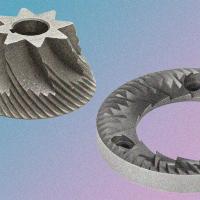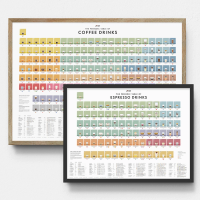Why conical burr 'microns per step' are always wrong.

We receive lots of thoughtful messages everyday regarding the coffee grind size chart with requests to include new grinder models, to refine existing graphs, and to include additional functionalities. We really value this feedback as it allows us to create a more precise and practical tool that simplifies brewing coffee at home.
However, a large proportion of the messages (nearly one a day) astutely point out the discrepancy between the grinder settings provided by the manufacturers, and the settings displayed on our graphs.
For example, 1Zpresso, a company that produces some of the most sought after manual coffee grinders, specifies that each click on the J-Max hand grinder moves the burrs 8.8µm (microns)1.
But on our chart for the J-Max (fig.1) we have the grinder settings distributed so that there's around 450 clicks within 1190µm, which is around 2.6µm per click.

That's a significant disparity of 6.2µm... and it's not just the J-Max. When you look up burr grinders online, whether hand-ground or electric, flat burr or conical burr, you'll find that many companies and manufacturers indicate a 'microns per step' specification. This value is often much lower on our graphs for many of those models.
Here are more examples of 'microns per step' values provided by manufacturers, compared to our chart figures (as of May 2024):
Timemore S3
Manufacturer— 15µm per click2On our chart — 8.6µm per click
Fellow Opus
Manufacturer — 50µm per click3On our chart — 23.5µm per click
KINGrinder K4 and K6
Manufacturer — 16µm per click4On our chart — 8.5µm per click
Varia VS3
Manufacturer — 10µm per number5On our chart — 6.25µm per number
So it's not just 1Zpresso, our graphs are consistently showing lower micron adjustments.
But before we explain why our data doesn't match, it's important to understand how 1Zpresso came up with a figure like 8µm per step in the first place.
It's probably explained by this simple calculation:
The J-Max has 90 clicks per 360°rotation of the adjustment dial. If each click is 8.8µm as 1Zpresso says, that makes nearly 800µm (0.8mm) per rotation. This grinder has a maximum of 5 rotations — meaning that the J-Max has a grind size range of up to 4000µm or 4mm (800µm x 5).
Now why is 4mm significant? It's significant because it just so happens that 5 rotations on the thread pitch (the screw part) of the adjustment dial equals 4mm exactly, as shown in the picture below (fig.2).

This means that when you rotate the the adjustment wheel 5 times, the inner burr moves 4mm vertically. Therefore, you can presume that 1Zpresso's 8.8µm figure derives from the vertical distance moved per click. The same calculation can also explain the values given by the other manufacturers.
So why is our 'microns per click' substantially lower than that of 1Zpresso?
This is because in the case of the J-Max, the vertical movement of the burrs is not equivalent to the grind size output of the coffee.
If the grind size of the J-Max was truly 8.8µm per click, the largest grind size would produce 4mm coffee grounds! Even the coarsest coffee you might ever grind (like for cold brew) should never exceed 2mm in particle size.
1Zpresso doesn't explicitly say that the 'microns per step' value is for coffee grind size. The exact wording they give is "each click moves the burr 8.8µm."6 Additionally, 1Zpresso's grind size chart7 for the J-Max doesn't go up in 8.8µm steps either — the ranges are much finer and more accurate to the actual grind size.
So why does 1Zpresso (and the other coffee grinder companies) provide 'microns per step' that aren't the direct adjustments in coffee grind size?
This is because they are all conical burr grinders.

There are two predominant burrs types: conical and flat (fig.3). They have entirely different shapes, and it's this difference that is causing confusion.
It's the shape of the conical burr that makes it hard to predict what the grind size will be for any given setting.
For flat burrs however, the vertical movement IS equal to the gap between the burrs, which in turn is equal to the coffee particle size.

This is because flat burrs are two plates parallel to each other, so when one plate moves vertically away from the other, the resulting gap is the same distance (fig.4).
So if you adjust the burr 400µm vertically, the size of the coffee will be around 400µm in size.
If you know what the vertical micron adjustment is for one click, you can easily calculate and adjust the settings to achieve the grind you need. After dialling-in a few shots, you should be hitting the best settings quite quickly.
But for conical burrs, it's not so simple.

To better demonstrate this geometric problem, we simplified the shape of the conical burr set, removing their protruding blades and ridges (fig.5).

In this example (fig.6), we lowered the inner burr the same distance we lowered the flat burr. Notice that the burr gap is significantly smaller than the vertical distance travelled.
This is because the cutting surfaces of the burrs are at a steep angle to the horizontal surface.

This diagram (fig.7) illustrates how the equal vertical displacement of two surfaces results in progressively smaller gaps as the angle gets steeper. The left-most plates best representing flat burrs, the right-most best representing conical burrs.
Coffee grinder manufacturers are definitely aware of this problem, but because conical burrs are much more complex in shape, calculating the grind size at each setting is difficult. So they resort to giving the vertical adjustment values which are easy to calculate.
You might wonder why these companies knowingly share such misleading values to customers. It may be due to competition with other companies pushing them to display their grinders' capabilities with detailed specifications. Mainstream coffee brewing has become far more scientific and methodical than ever before, so simple claims like "suitable for grinding espresso to French press" isn't enough to persuade a continuously informed customer base.
This is why our graphs for conical burr grinders have the settings much finer than the vertical steps provided by manufacturers. The data we compile to create each graph is based on popular recipes, instruction manuals, product reviews, and of course, first hand testing.
So if you see a micron adjustment specification for a grinder you want to acquire, make sure you know what it actually means — either it's vertical adjustment or grind adjustment.
If you're getting a flat burr grinder, don't worry — the grind size and vertical adjustment are essentially the same. If it's a conical burr grinder, expect that the grind size adjustment per setting will be smaller than mentioned (which isn't a bad thing!).
But don't use those values to calculate the setting for your brew method. Use our awesome chart generator to find the correct grind size for your brew method!


